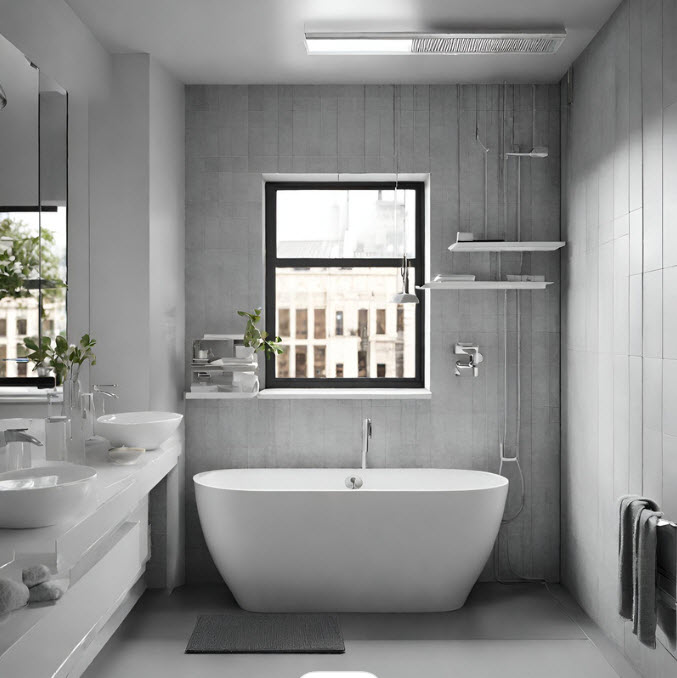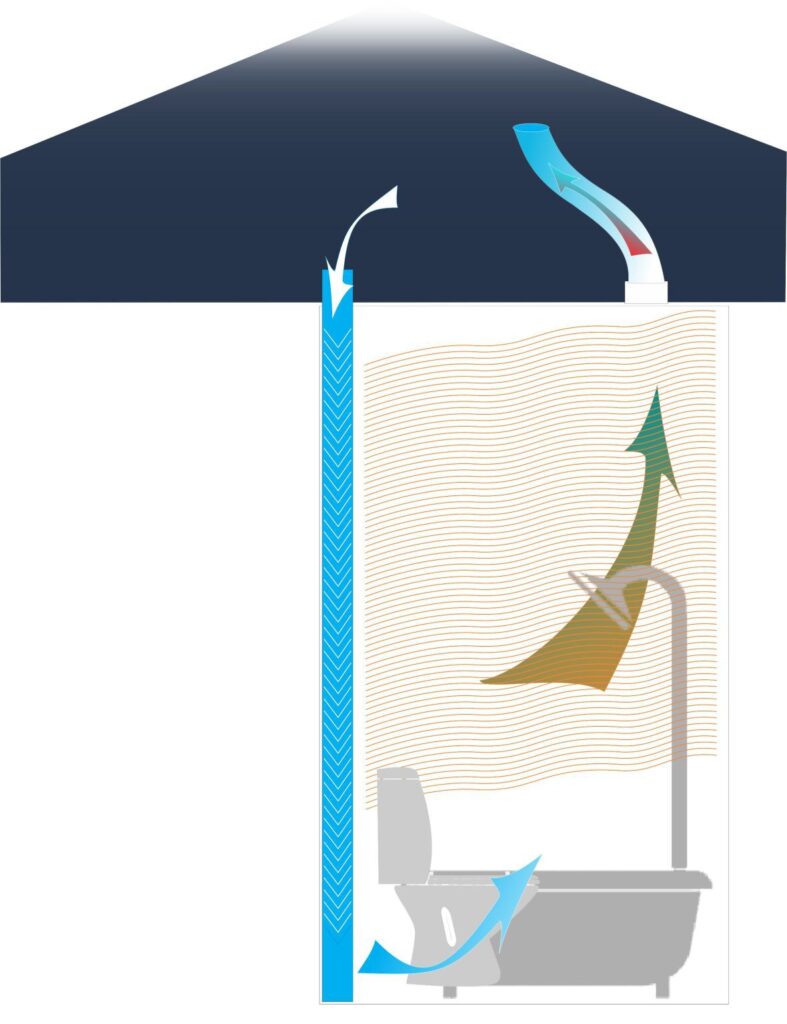The bathroom is a major source of moisture generation and other pollutants. As bath designers, we need to be aware of ways that we can improve indoor air quality, control moisture, and create more positive environments in terms of safe air and surfaces, and energy usage.
As whole house design becomes more technically sophisticated in response to environmental issues, we as professionals will need to know the resources available to take us into a more advanced design and specification process. This overview will point out some of the issues and offer some design and product considerations.

Major Concerns
Moisture Management: A Primary Concern
The number one bath concern expressed by the technical experts I spoke with was moisture. The typical bath doesn't have an exhaust system that adequately removes moisture, nor does it replace fresh air. Moisture that stands for more than 24 hours promotes mold growth. Condensation caused by warm, moist air hitting a cooler surface can run down that surface and pool.
If allowed to progress, this often results in damage to wall coverings and window trims, as well as other structural damage and health hazards. According to the American Lung Association, 40 million Americans suffer from allergies, 15 million have asthma and mold and mildew are known irritants.
Problematic Areas: Windows and Cantilevered Tubs
Two common problem areas are windows and cantilevered tubs, which are difficult to air seal and insulate. As designers, we need to address these areas. In the case of the cantilevered tub, we must be sure that the area is built and insulated to be completely airtight, particularly in colder climates. As one expert recommends, the best solution is to avoid this type of design. We must take responsibility for creating designs that do not go beyond the realistic expectations of the properly qualified contractor.
Energy, Noise, and Safety Considerations
Additionally, we must attend to issues of energy usage, noise levels, and safe air, surfaces, and products. As designers, we must select products and materials that will support the variety and volume of activity in the bathroom, while creating a safe and comfortable environment.
Materials & Products
Given that bathroom activity makes up as much as 50 percent of a household's water usage, the temperature, purity, and amount of water being used are worth attention. The low-volume (1.6-gallon maximum) flush on toilets seems to be a reasonable mandate. This reduced water usage has resulted in some models that are pressure-assisted. Although these are usually noisier and more expensive, they are more effective than those relying on gravity, and the added cost is quickly made up in savings on water bills.
Water Purification Systems and Heating
Among the many water purification systems available, reverse osmosis systems are a popular choice, located as water enters the house or at the point of use. Showerheads, now required to have a flow of 2.5 gpm (gallons per minute) or less, save significantly over the older ones that used as much as 6 gpm. Adding aerators to faucets can reduce flow to less than 1 gpm, sufficient for most bath activities.
Sometimes, the age of the heater or an increased need (caused by an added bath or a whirlpool) will dictate a new or additional water heater. Sealed combustion gas is receiving attention for its reduction in energy usage and the fact that it reduces the risk of air pollution entering back into the house. Various versions of a "demand" system pump cold water into the water heater and back out to its point of use, but each must be examined for its intended application. Water heaters should be power-vented.
Lighting and Natural Light Sources
Lighting, critical to the ambiance and safe use of the space, is also an opportunity to impact energy savings. Choose fixtures designed for use in wet areas. In the case of recessed fixtures, insulation is critical, not only for air sealing but for preventing moisture buildup.
Fluorescent lamps have come a long way in both light quality and design. Working with a warm temperature (2700K) can approach the sense of incandescent, and a color rendering index of 80 or higher can help to create a more natural light. As these light sources use 1/4-1/3 of the energy of an incandescent lamp and can last 10 times as long, they are worthy of attention. Regarding natural light sources, light pipes or solar tubes provide natural light with the least amount of energy loss.
Windows and Passive Solar Energy
Windows with southern exposure are an opportunity to incorporate passive solar energy to reduce heat requirements.
Low VOC Emission Materials and High-Efficiency Exhaust Systems
The use of low VOC (volatile organic compound) emission materials and products is an area that requires the designer to research the products being specified. The goal is to minimize the use of products with high levels of VOCs. Water-based adhesives, low VOC paints, and non-porous materials like ceramic tiles and hardwood cabinets are a start. Cabinetry made from materials certified as source (sustainable forests) and content (low VOCs) is now available.
High-efficiency exhaust systems and controls have the greatest impact on the bath environment in terms of air quality. A fan system should include ventilation and some consideration of makeup air. Many systems on the market allow for several areas to be vented through a single power source. This provides an opportunity to prevent odor, moisture, or bacteria at more than one point of origin.
Ventilation Considerations and Final Thoughts
Consider the size of the space and how frequently it will be used in choosing the right system. In addition, consider the noise level of the fan (under 1.5 sones is recommended), and its size in cubic feet per minute (CFMs).

A humidistat control in place of a manual switch will improve moisture control. Given the emphasis on tight construction of homes today, correct sizing and provision for makeup air should be calculated with the HVAC (heat, ventilation, air conditioning) specialist. All ventilation should be to the outside, and not to an attic or garage. Finally, air quality throughout the house can be further improved through filtering systems and measured through detectors of such things as CO2.
I'm not suggesting that professional bath designers must become technical experts on everything from cabinet composition to tile installation to ventilation. But we must raise our awareness and understanding of these issues as the spaces that we are designing evolve into the 21st century. We can do this by educating ourselves through the available resources and area experts.
 (0)Dislikes
(0)Dislikes (0)
(0)






